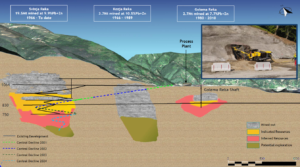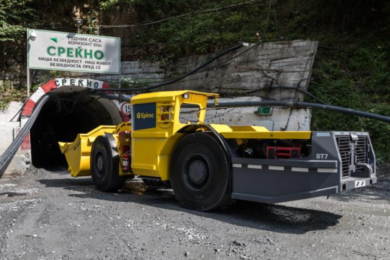In its just released 2021 Sustainability Report, Central Asia Metals PLC (CAML) set out its main decarbonisaion goals. For its existing assets, the Kounrad surface copper leach operation in Kazakhstan and Sasa underground lead-zinc mine in North Macedonia, it has set a target to reduce Scope 1 and 2 emissions by 50% overall by 2030 as compared to a 2020 base year. Additionally, it is committed to achieving net zero by 2050. Part of this includes potentially transitioning to a battery electric fleet at Sasa. CAML stated: “The Sasa team, alongside mobile plant contractors Epiroc, is undertaking an analysis into the practical and financial implications of purchasing electric underground machines for drilling, loading, and hauling of ore. Further details will be provided in due course.”
Sasa is already a long term partner with Epiroc – this included in 2020 adding new pieces of Epiroc underground equipment for its Central Decline development, namely three ST7 Scooptram loaders, two Boomer drills, a Diamec exploration diamond drill and a 20 t MT2010 Minetruck, along with a Putzmeister SPM 4210 WETKRET shotcrete unit and mixer to enable fully mechanised placement of shotcrete, replacing the handheld units previously used underground. New Paus personnel carriers have also been added in recent years. The mine also has an Epiroc simulator which helps to train Boomer operators. CAML has Newtrax software installed on a number of its machines producing reports on vehicle utilisation, availability and number of cycles; while two of its loaders fitted with line of sight remote
loading systems.
The possible move to a BEV fleet to cut Scope 1 emissions coincides with Scope 2 progress. The Sasa processing plant is a standard froth flotation system, operated by grid power. Whilst a large proportion of the available grid power in north macedonia is coal-fired (and therefore reflected in Scope 2 emissions), Sasa recently negotiated to acquire solely renewable power from its provider, EVn, from 1 July 2021. As a result of this mid-year development, 49% of Sasa’s power purchased in 2021 was renewable, representing a substantial increase from 6% in 2020.
CAML took 100% ownership of the Sasa underground zinc-lead mine in November 2017. The mine is located in north eastern North Macedonia, approximately 150 km east of the capital city, Skopje, and 10 km north of local town, Makedonska Kamenica. The Sasa deposit was discovered during a period of exploration between 1954 and 1965. Trial mining commenced in 1965 and, in 1966, the mine commenced commercial production as a state-owned entity. The mine closed in 2002 and was placed into bankruptcy due to lack of funding. The Solway Investments Group subsequently purchased the mine, invested in new equipment and operations resumed in 2006. Solway Group later sold the mine to Fusion Capital and Orion Mine Finance Group in 2015.
Sasa produces approximately 820,000 t of ore each year. Accessed by adit, the Svinja Reka deposit is currently mined using a sub-level caving method, which utilises the geotechnical characteristics of the weak hanging wall to allow the rock to cave naturally into the void remaining after ore has been blasted. Main haulage levels are at 80 m intervals, with sub-levels every 7 m. Ore drives are typically 3.5 m by 3.5 m. Ore is mined using a top down approach without backfill. Ore is drilled using single boom jumbos, blasted and then excavated with underground loaders.

From the second half of 2022 the Sasa team will transition to a new more efficient and selective mining method, namely cut and fill stoping, with approximately 90% of ore being extracted using this method by 2024. The voids will then be backfilled with paste material containing tailings to provide support, rather than allowing the roof to cave as is the case with the current sub-level caving method. The project comprises the development of the new Central Decline, as well as construction of a paste backfill plant and associated reticulation pipework, and a dry stack tailings plant and associated landform.
This decline will be larger than the existing XIVb decline access to the mine and will provide increased ventilation, easier access for reticulation infrastructure and the potential to increase ore mined in the medium term. The profile of the decline has been increased to facilitate the potential future use of slightly larger underground electric vehicles. Development of the portal on surface began in August 2021 and, by the end of that year, 71 m had been developed from surface and a total of 432 m were developed from underground on the 910 m level. The total length of this decline will be approximately 4 km and construction will be undertaken in three stages during the next four years.
Once blasted, 70% of the ore is then sent via ore passes to the 830 m level where it is transported by rail wagons to the Golema Reka shaft for hoisting, and the remaining 30% is hauled to surface via the adit. Once at surface, ore is then crushed in three stages. The milling circuit then involves two rod mills, followed by spiral classifiers and then two ball mills to ensure material is the appropriate size for liberation by flotation at approximately 74 microns. The processing plant then operates both lead and zinc flotation processes, producing separate concentrates that are filter pressed to produce products containing 5-9% moisture. Silver is also produced and this reports to the lead concentrate. The lead concentrate contains some 73% lead and the zinc concentrate contains around 49% zinc. The concentrates are stored in two separate bays before being loaded into haulage trucks for sale to smelters.










